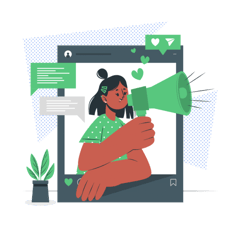5 reasons why Cultural Institutions should launch online fundraising campaigns

It can't be denied that digital fundraising platforms are a must for any type of organization in today's age, including cultural institutions. They have proved to be a stable channel to secure funding, increase visibility, and helped many organisations survive during the pandemic. Let's look at how this took place.
During the first wave of the pandemic, the response of individuals committed to helping hospitals was remarkable. Hospitals were overwhelmed by both in-kind and financial donations. Many people decided to support, for the first time, the hospital staff mobilised in the fight against COVID-19 and to participate in the financing of medical research.
It is evident that the pandemic has accelerated the digital transformation of hospital fundraising, and raised awareness for this sector.
But what about the cultural sector, which suffered greatly from closures for months?
For the second wave, the cultural sector, which was less prominent in digital fundraising, realised the potential and began taking the same path by launching donation campaigns aimed at the general public. More and more cultural institutions are developing their digital fundraising.
The Louvre Museum started a trend in 2018 by raising funds online from the general public. In 2019, the Château de Versailles followed suit. They set up donation forms to raise funds online for the first time in its history.

Other major institutions such as the Institut de France or the Philharmonie de Paris have also launched initiatives. The Philharmonie pushed further its fundraising strategy this year, by opting for a white-label crowdfunding platform for its annual “Giving for Demos” campaign.
Digital fundraising has also been the top choice for other institutions such as the Louvre-Lens, which launched a campaign for the general public on GivingTuesday. Or the Bordeaux Opera House, which is inaugurating a fundraising campaign for the general public at the launch of the season. The Domaine de Chantilly is preparing a platform to be launched in December, a strategic period to collect donations.

Museums, theatres, national estates, castles and cultural centres can no longer rely on ticket sales for income. They must find new ways to raise funds from a larger number of supporters. Online fundraising may be one of the only ways to guarantee the financing of their projects. And for some, the sustainability of their institution.
Making an exhibition, visiting a monument, attending a concert or seeing a show were activities that were put on hold. And people became aware of how much cultural activities were missing from their daily lives and how essential they are to our well-being.
When faced with that sad reality, the calls for support by cultural institutions were surely heard more loudly by individuals because supporting culture today is, for each one of us, a way to make sure that in the future we will be able to enjoy it.
 Now more than ever, cultural institutions are legitimate in soliciting the generosity of individuals. The institutions that we mentioned as examples above have understood this through their fundraising initiatives.
Now more than ever, cultural institutions are legitimate in soliciting the generosity of individuals. The institutions that we mentioned as examples above have understood this through their fundraising initiatives.
For those cultural institutions that are still hesitating, here are 5 major reasons to set up an online donation platform or launch a crowdfunding campaign:
1. Acquire new donors & secure funding
 Online fundraising proved to be a lifeline for all nonprofit organizations in the complicated context that was Covid.
Online fundraising proved to be a lifeline for all nonprofit organizations in the complicated context that was Covid.
Today, digital fundraising platforms offer a stable means for cultural organizations to secure funding by providing them with a wider reach and the ability to engage with a diverse audience, regardless of geographical barriers.
This is a chance to expand your network of supporters. Reach out to companies, major donors, and your initial group of dedicated visitors. Individuals should be given the opportunity to take part in safeguarding the cultural sector.
2. “Offering a service” to your donors by allowing them to support you easily.
 To raise funds efficiently, it is important to propose secure donation platforms where it is possible for your donors to have a smooth experience. For example, allowing them to make donations through their preferred form of payment. Whether it's credit card, direct debit, and even one-click mobile payments like Apple Pay, Google Pay, or PayPal.
To raise funds efficiently, it is important to propose secure donation platforms where it is possible for your donors to have a smooth experience. For example, allowing them to make donations through their preferred form of payment. Whether it's credit card, direct debit, and even one-click mobile payments like Apple Pay, Google Pay, or PayPal.
With a powerful donation form you can customise your donation grid to propose amounts catered to your donors' history of giving, or that are specific to a project you would like to fund. You can customise Thank You emails for each donation form, and nurture the relationship with those donors.
Your organisation can as well offer the option to give one-time or monthly through credit card or direct debit. The process is so intuitive that it will help recruit more recurring donors and increase secure more resources. This will allow to better calculate budgets throughout the year in a sustainable way and help your institution grow.

3. Responding to operational changes.
The increase in remote working and changes in the way people use money have raised new operational changes. There is a decrease in cash transactions. Also, fundraising teams working from home can no longer receive and process donations by cheque.
This is not a bad thing! Digitising your fundraising also means being able to respond to these new norms, gradually changing donor behaviour, and even better, reducing donation management costs.
4. Unity is strength.
 Cultural organisations all face the same challenge. Through their individual actions for the general public, they democratise the donation of “uninitiated” individuals to support the cultural heritage as a whole.
Cultural organisations all face the same challenge. Through their individual actions for the general public, they democratise the donation of “uninitiated” individuals to support the cultural heritage as a whole.
The more cultural institutions solicit the generosity of the public, the stronger the response will be! Donors in the voluntary solidarity sector are often multi-donors. Why should the cultural sector be any different?
5- Increased visibility
 Launching fundraising campaigns means continuing to be visible to the general public.
Launching fundraising campaigns means continuing to be visible to the general public.
It is a powerful way to strengthen brand awareness, showcase your mission, projects, and cultural impact to a global audience. Inciting audiences you never thought you could reach to visit your cultural sites and support them.
To conclude, having the right online fundraising tools can empower your cultural organisation to raise more, save time and money. Want to find out more about the benefits of digital fundraising solutions? Read our article: Online Fundraising platforms: not just a smart investment, but a necessity.
